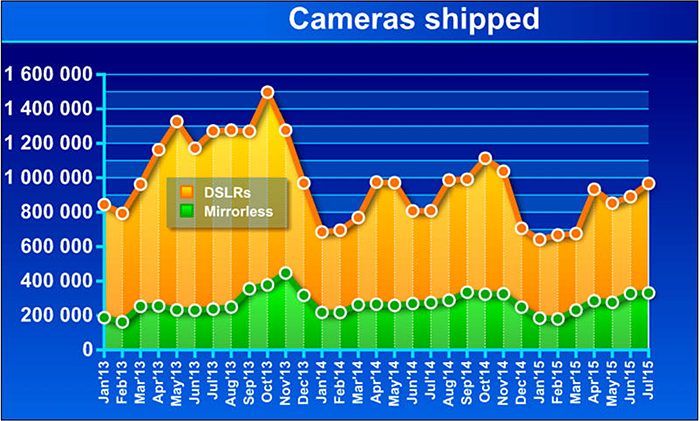This is, if my memory serves me right, what an 800 lbs gorilla looks like:
I wonder what the breakdown of this chart would be?
For example, is GoPro counted amongst the Mirror-Less statistics? If the answer is yes for what is touted as "the top selling camera in the world", then there can't be much left for all the other mirror less models.
http://gizmodo.com/how-the-gopro-became-the-best-selling-camera-in-the-wor-1462288770
All that aside, a quick search of top selling cameras reveals that Canon and Nikon already make the more popular mirror-less cameras. So, if we divvy up the Mirror-less sector into cameras suited for advanced amateurs or Pros (like the A7 stuff from Sony), I suspect they'd barely be a blip on that chart … in the same way that a D810, Canon's latest 5D, or any pro spec DSLR would probably barely register on this chart, if at all.
Personally, I like this fellows' even handed take on the subject at hand:
http://www.slrlounge.com/dslr-vs-mirrorless-cameras-future-of-photography/
If one buys into that POV, then it seems co-existence is the foreseeable future.
Optional read: my personal approach to the subject:
Frankly, I
do buy into co-existence, and that is my current state of trimmed down photographic gear as I retire/transition from semi-pro, to mostly personal photography. If I still shot weddings/events, I'd overwhelmingly be equipped with dual card DSLR gear sporting sophisticated lighting features. The Sony A7R never really made the cut.
My current kit: One B&W Leica mirror-less rangefinder with an OVF, one Sony A7R Mirrorless with EVF … one Leica S DSLR with an OVF (and a second S camera coming). Oh, and I can't exclude the iPhone. So, my eggs are not all in one basket, and I still like the notion of "Horses for Courses". In very few cases can one "system" fully take the place of the other.
The S camera is dual shutter, shoots to two cards, and has the biggest, cleanest and most realistic view-finder … neither of the others can do all that. I can use my Leica M 21/1.4 on the A7R without the clunky aux viewfinder that the M camera requires, and it is high res without the size of the S camera. The rangefinder provides a unique content oriented view of the world unfettered by focal length effects other than framing that the other two SLRs cannot. The iPhone wins based on … immediacy, being there, and instant sharing … so it always wins when high-aesthetics or making prints are less important. When I shoot with the Leica MM, the companion to it is the iPhone for the inevitable "color snap" opportunities that may arise while on a "serious" B&W hunting trip.
"How often do you look at the final image output using an optical viewfinder? A: Never."
I quess that's the difference between needing to confirm what you are doing with the camera, and intuitively knowing. I think EVF cameras are a really cool teaching aid, but as far as being representative of what may get printed later, it hardly ranks as being better or worse than OVF.
- Marc

